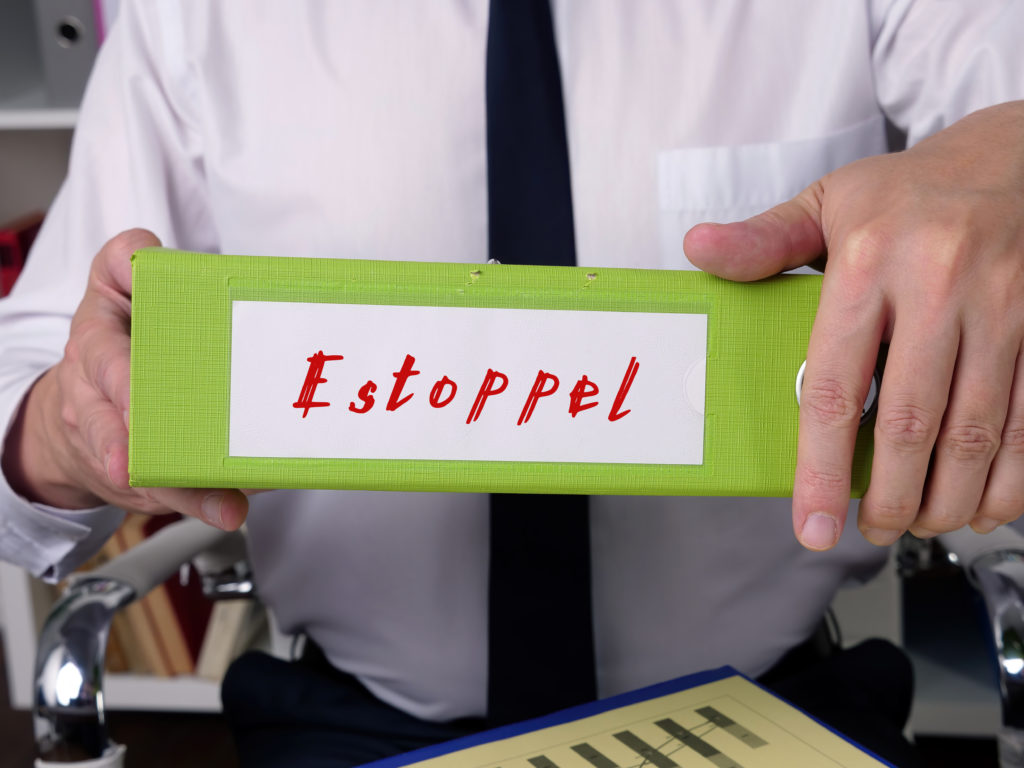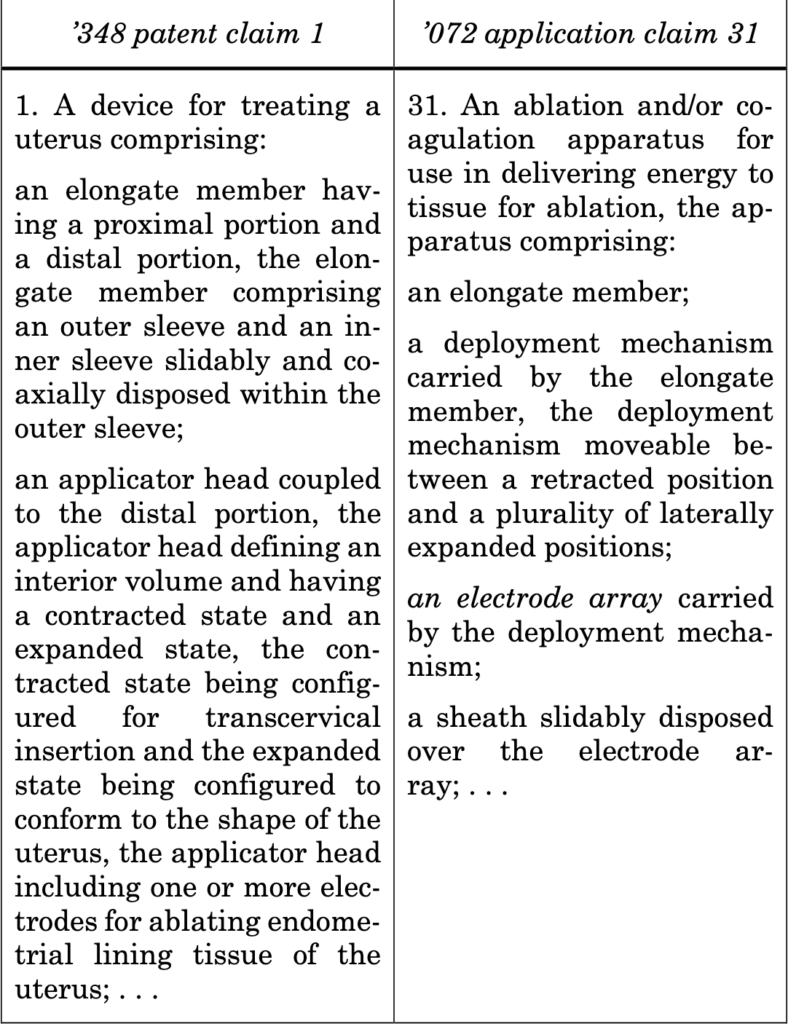“A claim canceled in response to a restriction requirement is no less a viable claim just because of its cancelation in response to a restriction requirement.” – CAFC
 The U.S. Court of Appeals for the Federal Circuit (CAFC) today, in a precedential decision, revisited its 2020 holding that the doctrine of assignor estoppel bars Minerva Surgical, Inc. from challenging the validity of Hologic Inc.’s patent directed to a device for treating a uterus. The decision comes on remand from the U.S. Supreme Court, which vacated the 2020 ruling and returned it to the CAFC for further consideration of the justices’ determination that the doctrine of assignor estoppel comes with certain limits.
The U.S. Court of Appeals for the Federal Circuit (CAFC) today, in a precedential decision, revisited its 2020 holding that the doctrine of assignor estoppel bars Minerva Surgical, Inc. from challenging the validity of Hologic Inc.’s patent directed to a device for treating a uterus. The decision comes on remand from the U.S. Supreme Court, which vacated the 2020 ruling and returned it to the CAFC for further consideration of the justices’ determination that the doctrine of assignor estoppel comes with certain limits.
Supremes Rule
The Supreme Court ruled in June 2021 that assignor estoppel—which bars the assignor of a patent from later attacking the patent’s validity—“is well grounded in centuries-old fairness principles…[but] applies only when the assignor’s claim of invalidity contradicts explicit or implicit representations he made in assigning the patent.” Thus, while the Court rejected Minerva’s request that the doctrine be abandoned, it vacated the CAFC’s 2020 judgment and remanded the case to address “whether Hologic’s new claim is materially broader” than the ones that were assigned.
In its original ruling of April 2020, the CAFC said that assignor estoppel barred Minerva from asserting invalidity of its assigned patents in district court, after Hologic sued Minerva for infringement of those patents based on a claim that had been broadened via a continuation application following its assignment. On appeal, the Supreme Court said that “a change in patent claims can remove the rationale for applying assignor estoppel.” Since the claim at issue had been broadened after Minerva assigned the patents, the Federal Circuit’s conclusion that it was “’irrelevant’ whether Hologic had expanded the assigned claims” was wrong. The Court said that if the new claim is “materially broader than the ones” assigned, their validity could not have been warranted on assignment. “And without such a prior inconsistent representation, there is no basis for estoppel,” wrote the Court.
Analysis on Remand
On remand, the Federal Circuit examined claim 1 of U.S. Patent No. 9,095,348 to determine whether it is “materially broader” than claim 31 of the June 23, 1998, U.S. Patent Application No. 09/103,072 filed by Csaba Truckai, one of the named inventors on the ‘348 patent. The ‘072 application ultimately issued as the ‘348 patent through a series of continuation and divisional applications. The CAFC addressed two key questions:
“(1) whether Mr. Truckai warranted claim 31’s validity at the time of assignment, considering the parties’ arguments regarding the implications of the 2002 cancelation; and
(2) whether claim 31 is materially broader than claim 1 of the ’348 patent—specifically, whether claim 31 is broad enough to cover moisture impermeable devices, or if instead it is limited to moisture-permeable devices.”
The court first found that a restriction requirement on claim 31 of the ‘072 application during prosecution that caused Truckai to cancel the claim “says nothing, implicitly or explicitly, about the patentability of claim 31.” Minerva had attempted to argue that the cancellation of the claim in 2002, two years before the patent was assigned, meant that Truckai could not assert the claim was valid at the time of the assignment. It also argued that claim 1 of the ‘348 patent was materially broader than claim 31 because claim 1 covers both moisture-permeable and moisture-impermeable devices, while claim 31 is limited to moisture-permeable devices.
On the first point, the CAFC said:
“Although claim 31 was canceled for purposes of further prosecution of the ’072 application, cancelation did not nullify the claim, as it remained viable for further prosecution in a divisional application filed by whomsoever owned the ’072 application. A claim canceled in response to a restriction requirement is no less a viable claim just because of its cancelation in response to a restriction requirement.”
Essentially, claim 31 “traveled” with the assignment of the application to Hologic. Importantly, the examiner of the ‘072 application had eventually allowed claim 31 on the merits prior to cancellation. Thus, Truckai’s representation at the time of assignment of the patent that the rights were valid and enforceable applied equally to claim 31. However, the court explained in a footnote that the decision should not be read to imply that a claim canceled for reasons other than to comply with a restriction requirement would be similarly considered part of the assignment.
Next, with respect to whether claim 1 is materially broader than claim 31, the court performed a side-by-side comparison of the two claims, shown below.

The court said the undisputed plain claim language suggests that claim 31 is not limited to moisture-permeable devices, as Minerva argued. And as to Minerva’s contention that the lack of an “applicator head” limitation in claim 31 means that the claim does not cover a device with a moisture impermeable applicator head, the court said that the language of claim 31 actually “supports the opposite conclusion: that the claim broadly covers both moisture-permeable and -impermeable applicator heads.” It also rejected Minerva’s additional arguments attempting to show the claim is limited to require moisture permeability, explaining that other claims of the ‘072 application included express requirements for moisture permeability, which shows that Truckai and the other inventors “did not intend to so limit that claim.”
Ultimately, the CAFC returned to its original reasoning that “’Minerva disputed none of the pertinent facts’ concerning assignor estoppel at the district court or on appeal, including: (1) that Mr. Truckai executed a broad assignment of his patent rights to NovaCept and later sold NovaCept to Hologic’s predecessor; (2) that NovaCept received appreciable value for those patent rights; (3) that Mr. Truckai founded Minerva and used his expertise to research, develop, and obtain FDA approval for Minerva’s [Endometrial Ablation System] EAS; (4) that his job responsibilities included bringing the EAS to market to compete with Hologic; and (5) that he is in privity with Minerva.”
And having found that claim 1 of the ‘348 patent is not materially broader than claim 31 of the ‘072 application, the Federal Circuit again found that the district court did not abuse its discretion in applying the doctrine of assignor estoppel. The court also reinstated its 2020 judgment on a number of other issues that were unaffected by the Supreme Court’s ruling.
Image Source: Deposit Photos
Image ID:439256300
Copyright:rummess

![[IPWatchdog Logo]](https://ipwatchdog.com/wp-content/themes/IPWatchdog%20-%202023/assets/images/temp/logo-small@2x.png)

![[Advertisement]](https://ipwatchdog.com/wp-content/uploads/2024/04/UnitedLex-May-2-2024-sidebar-700x500-1.jpg)
![[Advertisement]](https://ipwatchdog.com/wp-content/uploads/2024/04/Patent-Litigation-Masters-2024-sidebar-700x500-1.jpg)

![[Advertisement]](https://ipwatchdog.com/wp-content/uploads/2021/12/WEBINAR-336-x-280-px.png)
![[Advertisement]](https://ipwatchdog.com/wp-content/uploads/2021/12/2021-Patent-Practice-on-Demand-recorded-Feb-2021-336-x-280.jpg)
![[Advertisement]](https://ipwatchdog.com/wp-content/uploads/2021/12/Ad-4-The-Invent-Patent-System™.png)






Join the Discussion
No comments yet.